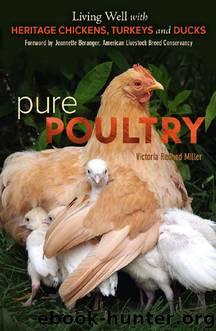Pure Poultry by Victoria Redhed Miller

Author:Victoria Redhed Miller [Miller, Victoria Redhed]
Language: eng
Format: epub
ISBN: 9781550925463
Publisher: New Society Publishers
CHAPTER 22
Farm-fresh Eggs: What’s the Big Deal?
I DON’T KNOW ABOUT YOU, but before we started selling eggs in 2008, I was frankly baffled by the terminology of egg carton labeling. Although some labels are periodically redefined, others remain consistent, for example, egg sizes. What’s so confusing about large and extra large? Well, nothing, once you know what it means.
Egg sizes are determined by weight. The standard large egg is 2 ounces. However, the difference between one egg size and the next is ¼ ounce; thus, a large egg is actually anywhere from 2 to 2¼ ounces, an extra large egg is between 2¼ and 2½ ounces and so on. Sometimes, because of their varying shapes, one egg might appear to be larger when they are both the same weight. So when sorting our eggs, we weigh each one to determine the size.
By the way, you cooks and bakers out there probably already know that most recipes calling for eggs specify the large size. Now that you know a large egg is 2 ounces, you’ll know what to do when you want to use a different size: Weigh the eggs until you have the equivalent weight of the eggs called for in the recipe.
OK, on to egg grades. Just a few years ago, I had not the slightest idea what this meant. Simply, an egg’s grade is an indication of freshness, Grade AA being the freshest. How is this measured? It is determined by the size of the air space at the wide end of the egg; this is easiest to see when candling (shining a bright light through the wide end). This air space gets bigger because the shell is porous, and over time the contents gradually evaporate. So, the smaller the air space, the fresher the egg.
With commercial eggs, the catch is that this standard of freshness is applied when the eggs leave the place of production, not when they arrive at your grocery store. You can’t tell just by looking at the eggs, right?
Here’s another egg carton label: Free range. This designation is unfortunately not as clear, in terms of definition, as it might appear. Technically, for eggs to be labeled “free range,” the hens must be allowed “access to the outdoors.” What does that mean? (David suggested that the hens are watching the Nature Channel while pumping out eggs.) In reality, it means very little. A commercial operation can comply with this requirement by simply installing one or two very small doors somewhere on an outside wall of their 20,000-hen facility, making sure the door is open part of the day. Honestly, now, how many of those hens, in a place that huge, ever have a chance of even seeing the door? And if they do go outside, who’s to say there is grass out there? It’s far more likely the door opens out onto the edge of a parking lot.
The main problem with the term “free range” is that you can’t know for sure. These eggs
Download
This site does not store any files on its server. We only index and link to content provided by other sites. Please contact the content providers to delete copyright contents if any and email us, we'll remove relevant links or contents immediately.
Turbulence by E. J. Noyes(7977)
The Thirst by Nesbo Jo(6876)
Gerald's Game by Stephen King(4607)
Be in a Treehouse by Pete Nelson(3996)
Marijuana Grower's Handbook by Ed Rosenthal(3640)
The Sprouting Book by Ann Wigmore(3559)
The Red Files by Lee Winter(3388)
The Remains of the Day by Kazuo Ishiguro(3341)
Sharp Objects: A Novel by Gillian Flynn(2983)
Christian (The Protectors Book 1) by L. Ann Marie(2669)
Organic Mushroom Farming and Mycoremediation by Tradd Cotter(2659)
The Culinary Herbal by Susan Belsinger(2450)
Stone Building by Kevin Gardner(2369)
The Starter Garden Handbook by Alice Mary Alvrez(2306)
Lilac Girls by Martha Hall Kelly(2271)
The Unlikely Pilgrimage of Harold Fry by Rachel Joyce(2241)
The Lean Farm Guide to Growing Vegetables: More In-Depth Lean Techniques for Efficient Organic Production by Ben Hartman(2106)
Urban Farming by Thomas Fox(2083)
Backyard Woodland by Josh VanBrakle(1909)
